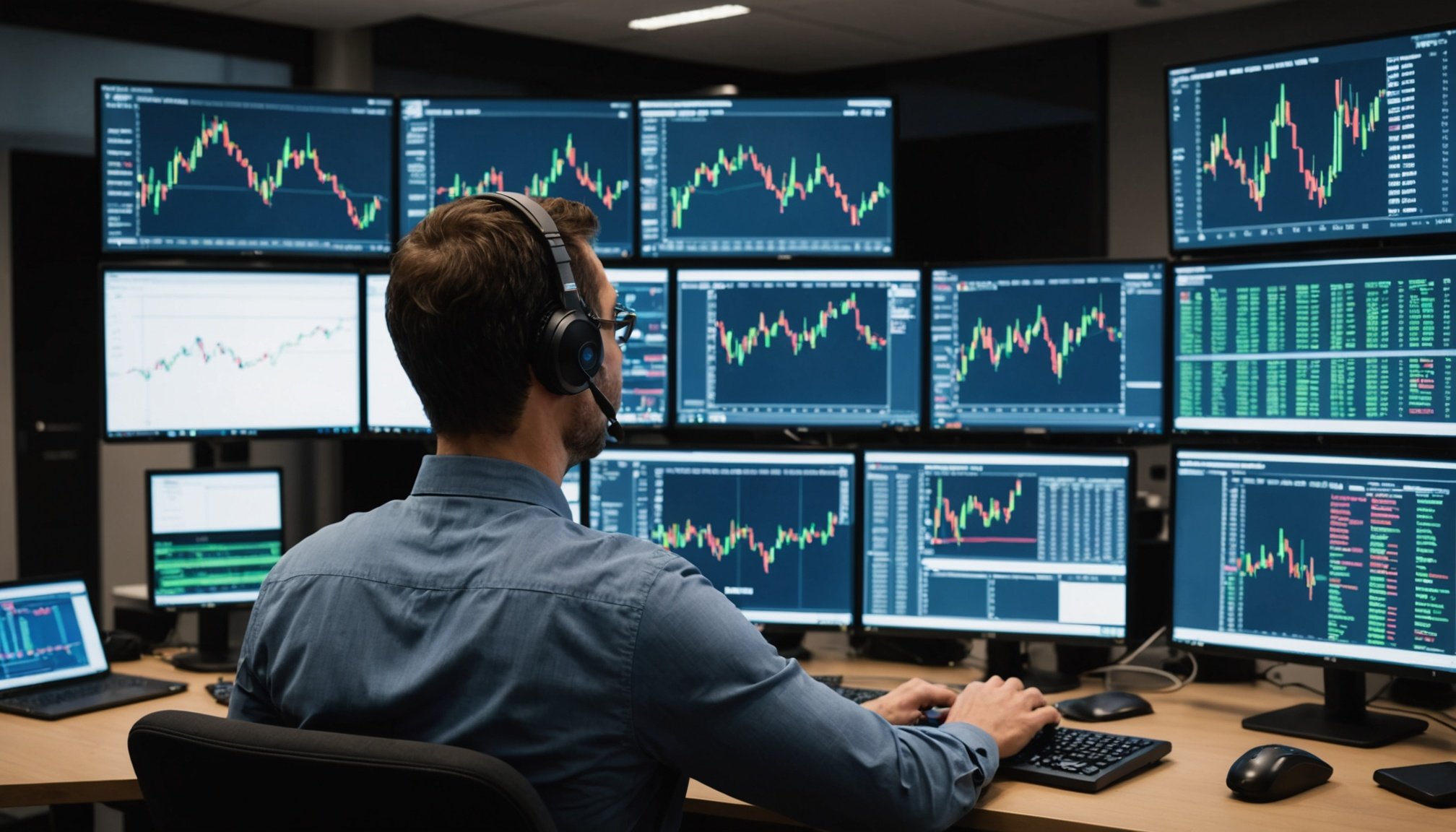Enhancing AI Algorithms for Financial Trading
Artificial Intelligence (AI) trading algorithms have transformed the landscape of financial trading, offering innovative solutions for complex market scenarios. These algorithms leverage financial trading optimization techniques to predict market trends with impressive accuracy. However, their success is heavily dependent on key performance metrics, which assess both efficiency and effectiveness.
AI trading algorithms evaluate their performance through specific metrics such as precision, recall, and profitability. Precision measures the accuracy of the predictions, determining how often the algorithms correctly identify profitable trades. Conversely, recall focuses on the coverage of these predictions, indicating the algorithm’s ability to detect all profitable opportunities.
Topic to read : Maximizing supply chain performance: harnessing predictive analytics for enhanced efficiency in uk fmcg companies
Beyond these metrics, the quality of data feeding into AI trading algorithms plays a critical role. High data quality, combined with robust data preprocessing, enhances the algorithms’ training and their capacity to optimize trading strategies.
Algorithmic trading techniques, which lie at the core, continue to evolve. Innovations in machine learning and data analysis have been driving this progress, enabling AI to analyze vast datasets faster and more accurately than ever before. Trust in these systems grows as they demonstrate increased precision, recall, and overall trading profitability, making them indispensable tools in the financial industry.
Also to discover : Create compelling commercials fast with an intuitive maker
Proven Techniques for AI Trading Success
Harnessing AI technology in trading can dramatically enhance your strategies and improve trading success. The key is in understanding and implementing advanced techniques.
Machine Learning Techniques
Machine learning can significantly optimise trading strategies. By leveraging powerful datasets, traders can develop algorithms that recognize patterns and predict market movements. Decision trees, neural networks, and random forests are popular machine learning methods enhancing trading decisions.
Backtesting and Validation
An essential component of successful trading methods is rigorous backtesting. By applying trading strategies to historical data, traders can validate the effectiveness of an algorithm before real-world application. Proper backtesting involves simulating trades based on past market conditions, providing insights into potential future performance. This helps enhance algorithm reliability and fine-tune strategies.
Customization Based on Market Conditions
Markets are dynamic, and successful trading requires adaptability. By customizing algorithms according to current economic indicators, traders can enhance performance. Deep learning models can contribute significantly by continuously learning and adapting to new data, thus refining trading strategies. Historical market simulations assist in understanding different conditions, enabling traders to tailor their approaches effectively. Customization offers an edge in predicting shifts and planning accordingly.
Case Studies of Success in UK Financial Markets
Delving into the world of AI-driven trading firms in the UK, one such success story is that of XYZ Trading Corp. Leveraging cutting-edge algorithms, they have revolutionized trading dynamics. Operating with precision and speed unattainable by human traders, these firms employ high-frequency trading to seize market opportunities.
Breakdown of Successful AI-driven Trading Firms
Prominent in this realm, ABC Trading observed significant gains by integrating machine learning into their trading strategies. By analysing vast datasets, their algorithms predict market movements, ensuring lucrative trades. Real-world trading examples demonstrate their prowess; they frequently adapt to market conditions, thereby securing profits even in volatile environments.
Analysis of Specific Trades and the Role of Algorithms
An illustrative instance is a remarkable trade involving GBP. By utilising sentiment analysis, the algorithm detected anomalies preceding a swift rise in value. Capitalizing on this insight, substantial profits were reaped, showcasing the potential of algorithmic precision.
Lessons Learned from Failed Trading Algorithms
However, not all algorithms succeed. Case studies in trading highlight the downfall of DEF Trading, overwhelmed by model overfitting. Their algorithms failed to adapt, emphasizing the importance of continuous optimisation and error correction. Such lessons are pivotal for firms aspiring to harness algorithmic prowess.
Tools and Software for Trading Algorithm Development
When creating algorithms for trading, knowing which trading software and AI development tools are best suited for the task is crucial. The availability of specialized tools can greatly enhance accuracy and outcomes.
Popular Software in the UK Market
In the UK, several platforms have gained popularity among traders. MetaTrader is a robust choice, offering features like backtesting and real-time analysis. QuantConnect provides cloud-based algorithm research and backtesting, catering specifically to traders and coders alike, while maintaining ease of access to various financial data sets, adding value through its diverse range of utilities.
Utilizing Open Source Solutions
Open source solutions have become quite significant in algorithm creation. TensorFlow is extensively used for building machine learning models, aiding in sophisticated predictions. These AI development tools allow developers to customize and innovate without having to start from scratch. Reducing development costs is another advantage, making these tools highly desirable for individuals and startups.
Integration with Trading Platforms
Seamless integration with trading platforms maximizes the efficiency of trading bots. By connecting algorithms through broker APIs, traders can execute strategies instantaneously. This direct connection saves time and minimizes errors. Platforms like MetaTrader enable traders to deploy and monitor these strategies within a single interface, streamlining the overall trading process.
Regulatory Considerations and Compliance
Navigating trading regulations is crucial for firms engaging in algorithmic trading within the UK. The Financial Conduct Authority (FCA) plays a pivotal role in shaping the regulatory landscape. Its rules ensure that algorithmic trading practices are conducted safely, efficiently, and transparently. For businesses, understanding these regulations is the foundation of compliance in trading.
To maintain compliance, firms should integrate robust strategies into their operations. This involves regularly reviewing their trading algorithms to ensure they align with the latest financial rules. Automated systems should be monitored to detect anomalies promptly. In AI-driven trading, this vigilance is even more critical, as the technology can evolve quickly, necessitating continuous reevaluation against AI and finance regulation standards.
Beyond technical adjustments, training employees to understand compliance requirements comprehensively is essential. Ensuring all members are well-versed in trading regulations protects firms from potential penalties and supports ethical trading environments. Utilizing external audits can also reinforce adherence, providing unbiased insights into a firm’s regulatory posture.
Establishing an effective compliance framework not only reduces risks but enhances trustworthiness in the financial ecosystem. By prioritizing adherence to AI and finance regulation, firms can navigate the complex world of algorithmic trading with confidence and integrity.
Common Pitfalls in AI Trading and How to Avoid Them
Artificial intelligence has revolutionised the world of trading, but it comes with its trading mistakes and algorithm pitfalls. Understanding these can help in crafting more effective strategies.
Overfitting in Algorithm Design
A recurring challenge in AI trading is overfitting during algorithm design. Overfitting occurs when an algorithm is tailored too closely to historical data, capturing noise rather than actual market patterns. This leads to poor performance in real-world scenarios. To combat overfitting, it’s crucial to maintain a balance by using robust datasets and validating the model with unseen data. Regular cross-validation and pruning techniques can also assist in fine-tuning the models effectively.
Ignoring Market Sentiment
Another common mistake is disregarding market sentiment. While algorithms can process vast amounts of data, they may overlook human behaviours affecting markets. Incorporating sentiment analysis allows traders to gauge public perception, adding an extra layer of market insight. By analysing news feeds and social media, traders can adjust their strategies according to the prevailing sentiment, thus achieving a more comprehensive trading model.
Lack of Risk Management Strategies
Not integrating risk management strategies is another significant pitfall. Many overlook this aspect when crafting AI-driven systems. To prevent this, develop strategic risk measures, such as setting stop-loss limits and diversifying portfolios. This ensures that even if one part of the strategy fails, the overall system remains stable.











